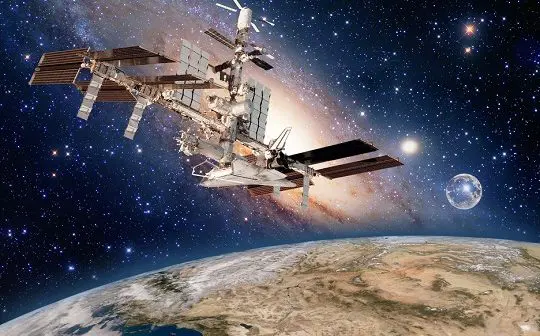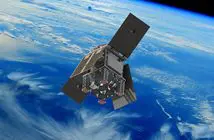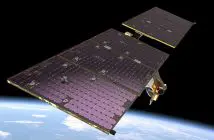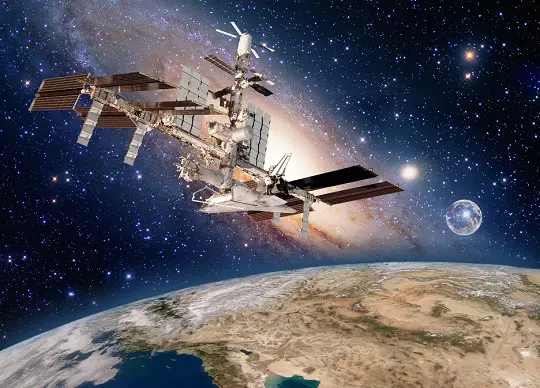
By Chris Flaherty
My Space Warfare Analysis Lab
The 1980s launch sector, largely began to become commercial and grow with a market dominated by large satellites being put into Geostationary Orbit for telecommunications, TV and other applications. Orbiting the Earth directly above the Equator at an altitude of more than 35,000 kilometres covering large geographical areas. The satellites often much larger than their Low Earth Orbit counterparts, are typically launched from Spaceports near the Equator to get an extra boost from the Earth’s rotation.
Low Earth Orbit satellites usually orbit within 1000 kilometres and do not need to follow a particular path around Earth providing faster communications etc. Can be launched into orbit from appropriate sites in different areas of the world. The focus of this talk will be on the Micro-Lift Rocket Market. To put this into context, as to how the current industry is structured:
| Light-Lift Rocket Payload from 500 to 4,000 kilograms to Low Earth Orbit. Estimated Launch Price: Around $50 M. | |||
| Micro-Lift Rocket Market Payload up to 500 kilograms to Low Earth Orbit. Estimated Launch Price: Around $10 M. | |||
| The Micro-Lift Rocket Market covers four basic classes of Satellite: | |||
| SMALL/MINI-SATELLITES 100-500 kilograms | MICRO-SATELLITES 10-100 kilograms | NANO-SATELLITE 1-10 kilograms | CUBESATS/ NANOSATELLITE Less than 1.33 kilograms (3 pounds) |
| The UK Space Industry Act, 2018 has a payload limit currently up to 500 kilograms to Low Earth Orbit. The Regulations dictate the Launch Licencing Program, that covers Insurance Level, liability and Range Management Issues. | CubeSats are built to standard dimensions of 1U: Unit (10 x 10 x 10 centimetres). Can be more: 2U, 3U, or 6U in size[1]. | ||
- Market analysis of the Space launch sector suggest opportunities exist for the UK to be at the forefront of the Global and European Small Satellite launch market[2].
- The potential launch market for Small Rockets (payload up to 500 kilograms), will likely see some 3,814 Small Satellites, equivalent to a mass of 146 metric tonnes (95 tons: commercial satellites; 45 tons: civilian; and 6 tons: military), launched till 2031 from the UK[3]. This number may be understated as SpaceX has already launched 1,500 Starlink Satellites since 2019. As of early October, 2020 SpaceX had launched more than 700 satellites into orbit, with a plan to release a total of 12,000 over the next five years, half of them by the end of 2024[4]. The megaconstellation could have a total of 42,000 satellites. The Starlink Satellite weighs 573 pounds: 260 kilograms. Likely representing a total launch mass of 12,037 tons.
- UK Government has announced several Spaceport sites, that fall into a Northern Cluster and the South-Western UK. Some of the Northern Cluster occupy the Far-Northern Scotland island chain and Northernmost Coastline. Largely dedicated to vertical ground launching Small Rockets, and are sited for Polar Low Earth Orbit. For instance there is Sutherland Spaceport (Scotland). It will host the Orbex Prime: Light-Lift Rocket. Its First-Stage Booster is planned to be reusable.
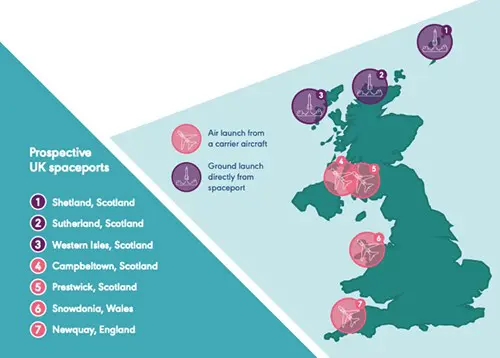
“Launch UK: Location of Seven Prospective UK Spaceports.”
- The second group of Spaceports, are part of the Northern Cluster and the South-Western region of the UK, in Wales, and Cornwall:
- Glasgow Prestwick Airport. Horizontal Air-Launched Facility, will handle: Hypersonic Flights, Micro-Gravity Flights, and Space Tourism.
- Campbeltown Airport. The military runway length is: 3,049 meters (10,003 feet). It was a back-up landing strip for the Space Shuttle. The longest in Europe and was an RAF and NATO base of operations till 1997. Anticipated to be a Spaceplane Port.
- Snowdonia North Wales, the former Llanbedr Airfield[5]. Has a partnership with B2Space, that plans to operate High-Altitude Operations using a Stratospheric Balloon. Called a Rockoon (rocket and balloon), the craft can put into Low Earth Orbit a Small or Micro-Satellite via a solid fuel sounding rocket. Carried into the upper atmosphere by a gas-filled balloon, separated and ignited.
- Cornwall Spaceport Newquay.
CORNWALL SPACEPORT NEWQUAY
- Newquay is the only UK Horizontal Spaceport to be operational currently. Satellite Launch Partner with Virgin Orbit. The Spaceport is dedicated exclusively to Virgin Orbit use. The ‘Cosmic Girl’ a former modified commercial 747, can carry a Small Rocket, with a payload up to 500 kilograms into Low Earth Orbit. Can take-off anywhere on the planet as long as there is an airfield that can accommodate a 747.
- Newquay, while primarily hosting Virgin Orbit, the Sierra Nevada Corporation now has an agreement for them to use the runway for orbital return of their Dream Chaser Spaceplane[6]. It is one of several potential sites around the world. For the Spaceplane it could be used as a primary and secondary landing site, as well as for Space payload deliveries (from the Sierra Nevada Corporation Space Station – Factory). Around Newquay a cluster of facilities is planned to be built processing payloads. Transforming into cargo for regular flights, as well as land, and sea transport options.
- Newquay a former Cold-War Period RAF Base, has one of the longest runway length in the UK: some 2,744 meters: 9,002 feet long which can be extended to over 3,000 meters. The Dream Chaser can land at any suitable runway that is 8,000 feet: 2,400 meters long, around the world without requiring specialized equipment[7].
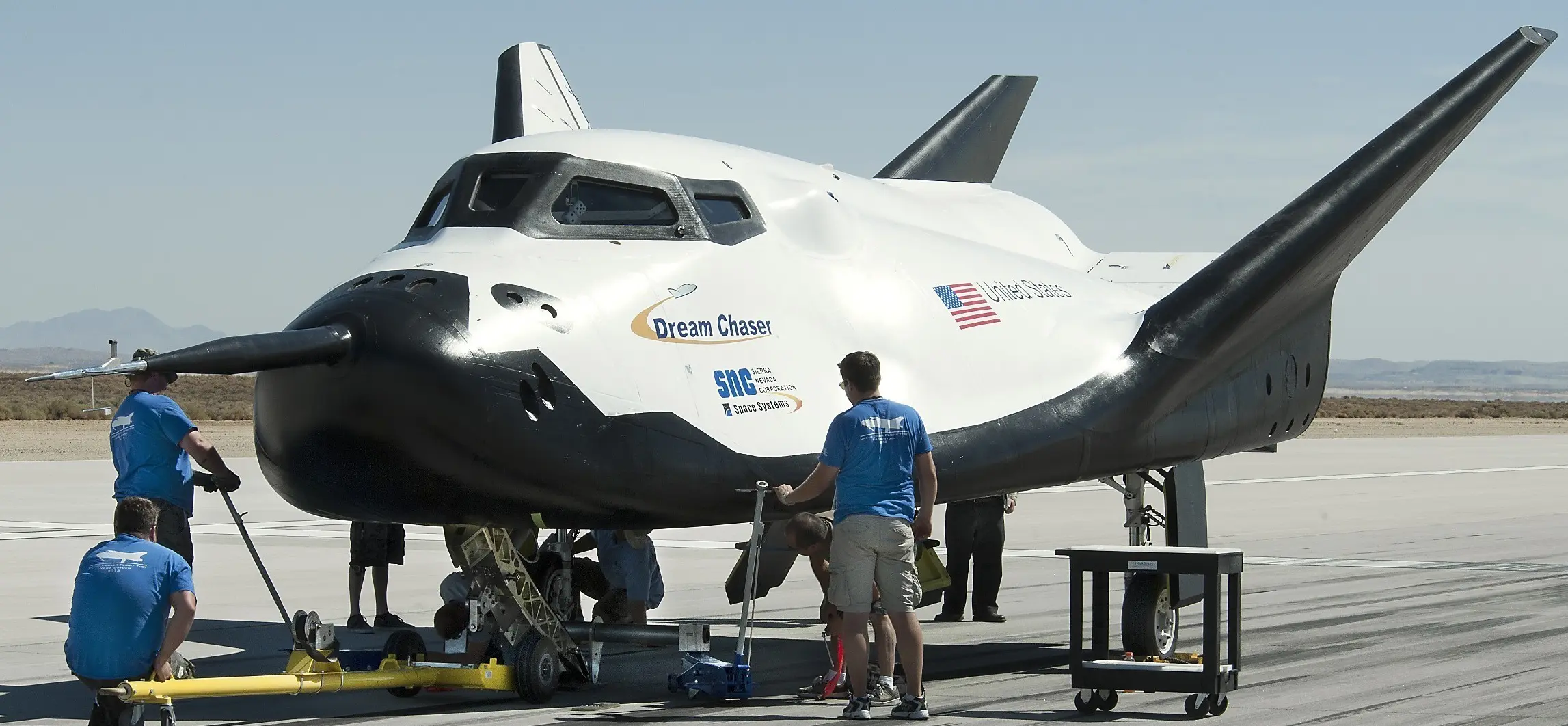
“Dream Chaser (Sierra Nevada Corporation) Orbital Spaceplane.”
- Newquay is located on the coast with uncongested and unrestricted airspace and one of the longest runways, was chosen for the following reasons: (1) Coastal location; (2) Low residential build-up; (3) Direct access over the seas; and, (4) Historical Space infrastructure. The ‘Cosmic Girl’ can take-off over the Cornwall coastline and track out to sea, and not have a wider impact on the safety zone.
- The Mission control for Newquay is the nearby Goonhilly Earth Station. This major Ground Deep-Space Communications Station, has Deep-Sea cable connections.
MERGED SPACEPORTS – AIRPORTS
- A marriage of operators looking for Spaceports, that best fit their operations, and International Airports. Are a major building block for a Space Economy to be set-up. Will have mixed Vertical and long runways for Horizontal Small Rocket launching, and Spaceplane landings. Landing pads for Earth-to-Earth Rocket Transporters will likely be seen. Clustered around the port will be servicing Space Factory out-puts facilities, and road, rail, sea, and air transportation.
- Currently, the merger has begun. For instance, in the UK, Glasgow Prestwick Airport has sought interest from companies in carrying out Horizontal Space Launches from its 2,986 meters: 9,796 feet long concrete case runway[8]. This is part of a commercial plan – The Ayrshire Growth Deal document:
“investment will be a catalyst to establishing Glasgow Prestwick Airport as the leading horizontal launch Spaceport in Europe, providing a range of services including Micro-Gravity Flights, Air-Launch of satellites, Human Space flight and Hypersonic Flight Services.”[9]
UK SEA LAUNCH
- Black Arrow Space Technologies is a Sea-Based NetZero Launch Provider (meaning using infrastructure, propellants, and debris minimization strategies to reduce environmental impact, and increase safety). Their commercial plan is generally understood:
‘[by]… having a Sea-Borne fleet of launch ships, don’t dig up protected areas, don’t disrupt coastal environments, don’t disrupt populations, simply through building a Spaceport in the wrong place, and by taking a Space fleet out from a current port infrastructure there is no disruption over and above the ordinary dealings of that port’. - One potential is to be able to get a larger launcher up to 5 tons, out into the Atlantic and launch from International Waters to Medium Earth Orbit (an altitude above a Low Earth Orbit, and below a High Earth Orbit, or Geostationary Earth Orbit).
- The Space fleet is planned to be based in South Wales (UK). Final payload preparation will take place prior to boarding a vessel and sailing to the launch site from a port of operations. Ultimately, the aim is to have ships based in key locations across the world offering global launch services.
THE SMALL SATELLITE INDUSTRY
- The Small Rocket Industry is primarily leveraging development of highly capable Small Satellites and Inter-Planetary Probes based on micro-miniaturized technology that is becoming more advanced. Small Satellite Industry and Companies commercially operate as an alternative to ride-share on a bigger rocket. Ride-share commercial disadvantages: (1) Constrained by timing; (2) Constrained by open Space opportunities on the next rocket going up; and, (3) Slaved to the primary orbit.
- Virgin Orbit’s 747 ‘Cosmic Girl’, is an Air-Based (Mobile Launch Platform), that serves as a Reusable First-Stage. It takes Rocket One to launch at 30,000 feet. This allows more payload, to achieve the same orbit, with the same thrust (compared to a Ground-Launch: requiring greater thrust – more fuels to undertake the same task).
- Virgin Orbit plan to add a third stage to their rocket, that has a new type of propulsion. NASA contract (June, 2021) with Exo Terra Resource LLC, a Solar Electric Propulsion company based in Littleton, Colorado. Currently in development with Virgin Orbit for a Solar Electric Propulsion Upper-Stage.
- This new type of propulsion is intended for Small Satellite deployment. The thruster while not that powerful compared to a chemical rocket; nevertheless, has greater efficiency, and is capable of producing thrust propelling the craft for a longer time span.
- Comparatively, current reporting on the Rocket Lab Kicker-Stage, it is capable of multiple burns, that can deploy satellites to different orbits.
AUSTRALIA
- Australia has similar national compatibility to the UK in terms of its economics, people and history, technology, R&D, trade relationships and commercial linkages, as well as Spaceport options, and Space access.
- In 2020, the Royal Australian Air Force (RAAF), announced its first Space payload launch from Australia. A DART rocket carrying a Defence payload was launched from the Koonibba Rocket Range in South Australia, marking the first commercial rocket launch to the edge of Space from Australia. At just 3.4 metres long and weighing 34 kilograms, the DART rocket is a fraction of the size of rockets launched by NASA and SpaceX.
- In 2021, rocket launches in South Australia were approved. Access to Polar Low Earth Orbit is achievable from South Australia’s Eyre Peninsula, and historical Woomera ranges for Small Payload Launching technology.
EQUATORIAL LAUNCH AUSTRALIA
- Equatorial Launch Australia: Arnhem Space Centre site in Australia’s Northern Territory, outside of the East Arnhem township of Nhulunbuy, approximately 12 degrees South of the Equator on the land of the Yolngu People.
SOUTHERN LAUNCH
- Southern Launch is an Australian Space company providing infrastructure and logistics support for Orbital and Suborbital launches of satellites and Space payloads.
- Southern Launch’s Whalers Way Orbital Launch Complex is a proposed rocket launching facility to be constructed in the locality of Sleaford near Port Lincoln on South Australia’s Eyre Peninsula.
- Approvals from landowners, have been recently finalised for the construction of the first two rocket launch facilities for the Whalers Way Orbital Launch Complex. The objective is to develop a Space Launch Facility which would offer rocket launches for both Australian and internationals.
GILMOUR SPACE
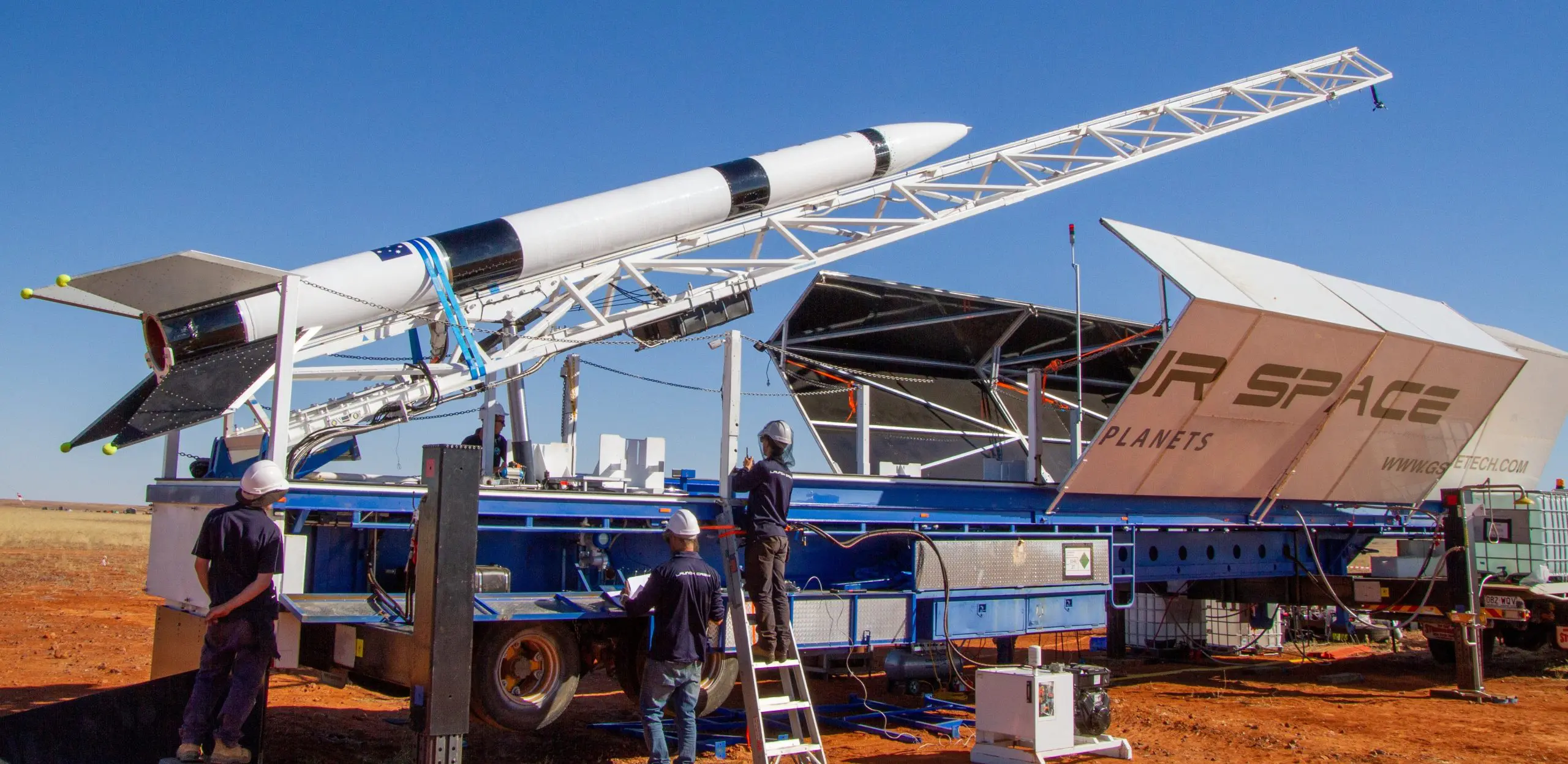
“Gilmour Space Technologies Test Rocket Mobile Launcher.”
- Gilmour Space has its Eris Orbital Rocket. This is 25 metres high, and is a three-stage rocket capable of launching Small satellites into Low Earth Orbit. Its diameter is 1.2 to 2 metres in different sections. Payloads range up to 215 kilograms to 500 kilometres into Sun Synchronous Orbit, or 305 kilograms to 500 kilometres into Equatorial Low Earth Orbit. The Queensland State Government, in Australia, has recently given its go-ahead for a Small Rocket launch site at Abbot Point.
SERVICES AND SUPPORT INDUSTRY
- One possible outcome of using an Australian Airport or port by a UK company is the services and support options. There could also be services, and support for Space tourism for an operator like Virgin Galactic at an Australian airport. Services and support for Spaceplane operations at a major commercial airport with suitable length runways, following the UK model could be a possibility. As could port support for Sea-Based launching vessels.
NEW ZEALAND
- Rocket Lab is a private U.S. aerospace manufacturer and Small Satellite launch service provider with a wholly owned New Zealand subsidiary. Rocket Lab Launch Complex 1, its primary launch site is on the Mahia Peninsula, east of Wairoa in the North Island, New Zealand. As of July 2020, a second pad at Mahia named Launch Complex 1B is under construction.
- In March 2021, A UNSW Canberra Space’s M2 CubeSat satellite observing weather patterns, bushfires, maritime surveillance and satellite communications was launched by Rocket Lab’s ‘They Go Up So Fast’ mission from New Zealand. The M2 mission was a collaboration between UNSW Canberra Space and the Royal Australian Air Force (RAAF).
GROUND STATION TRACKING
- In March 2021, Australia’s national science agency, the CSIRO has a new five-year agreement with Houston based aerospace company Intuitive Machines. The iconic Parkes radio telescope, owned and operated by CSIRO, will provide ground station support for one of the first commercial Lunar landings later this year. The new agreement with Intuitive Machines is to support multiple Lunar missions, including their first flight under NASA’s Commercial Lunar Payload Services initiative.
NUCLEAR THERMAL PROPULSION
- The concept of Nuclear Thermal Propulsion has a long history, for instance, around 1969 NASA designed its NERVA Engine. In January 2021, Rolls-Royce signed an innovative contract with the UK Space Agency for a study into future nuclear power options for Space exploration. Engineers from NASA estimate a mission to Mars powered by Nuclear Thermal Propulsion would be 20 to 25% shorter than the same trip using a Chemical Powered Rocket.
- Nuclear Thermal Propulsion uses a small nuclear fission reactor to heat a working fluid, usually Liquid Hydrogen, to a high temperature, that expands through a rocket nozzle to create thrust.
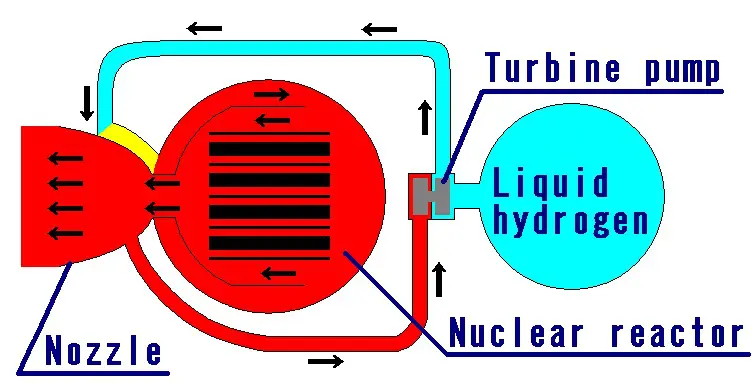
“A simple model of a Liquid Hydrogen fuelled Nuclear Fission Rocket Engine.”
SKYLON SPACEPLANE
- Skylon is a concept design for a Reusable Single-Stage-to-Orbit Spaceplane by the UK company Reaction Engines Limited.
- The SABRE: a combined-cycle air-breathing rocket propulsion system, is being designed to power an Air-to-Space Vehicle, from zero to orbital speeds, that industry experts view has the potential to be a game-changer.
- The Skylon design is for a hydrogen-fuelled Spaceplane, acting like an aircraft that would take-off from a purpose-built runway. It would then accelerate to Mach 5.4 at 26 kilometres: 85,000 feet altitude (compared to typical airliner’s 9 – 13 kilometres: 30,000 – 40,000 feet flying altitude). The Skylon uses the atmosphere’s oxygen before switching the engines to use the internal liquid oxygen supply to take it into orbit.
- Skylon could carry 17 tons: 37,000 pounds of cargo to an Equatorial Low Earth Orbit; or, up to 11 tons: 24,000 pounds to the International Space Station. The relatively light vehicle would then re-enter the atmosphere and land on a runway, protected from re-entry conditions by its ceramic composite skin.

“Skylon concept designs for a reusable Single-Stage-to-Orbit Spaceplane by UK company Reaction Engines Limited.”
AUTHOR
Chris Flaherty authored the Terrorism Research Center’s report – Dangerous Minds (2012). He was the co-primary author, along with Robert J. Bunker of the book – Body Cavity Bombers: The New Martyrs (iUniverse, 2013). Two essays of his, from 2003 and 2010 were reprinted in the Terrorism Research Center’s book – Fifth Dimensional Operations (iUniverse, 2014). He recently contributed a book chapter – The Role of CCTV in Terrorist TTPs, edited by Dave Dilegge, Robert J. Bunker, John P. Sullivan, and Alma Keshavarz, the book – Blood and Concrete: 21st Century Conflict in Urban Centers and Megacities, a Small Wars Journal anthology, published on behalf of the Small Wars Foundation with Xlibris (2019). Chris Flaherty is currently a Space & Defense Tech and Security News Regular Contributor.
CONTACT DETAILS: Dr Chris Flaherty https://au.linkedin.com/in/drchrisflaherty
[1] NASA. CubeSat. Fact Sheet.
[2] Spacetec Partners. 2021 Space Launch Market Analysis: HIE- Due Diligence Support (February).
[3] Spacetec Partners. 2021.
[4] Yan, M. Hunt, B. Mosher, D. 2020 What Elon Musk’s 42,000 Starlink Satellites Could do for — and to — Planet Earth. Business Insider Australia (10 October).
[5] Evans, A. 2020 Near Space Test Flight Takes Place at Spaceport Snowdonia. North Wales Chronicle (11 March).
[6] Spaceport Cornwall. 2021 Sierra Space Enters Into International Agreement With Spaceport Cornwall for Dream Chaser Spaceplane; Bolsters UK Space Industry. Business Wire.com (9 June).
[7] Taylor, F.W. Allison, C.J. Lee, C.L. 2014 Challenges and Opportunities Related to Landing the Dream Chaser Reusable Space Vehicle at a Public-Use Airport. Space Traffic Management Conference. Sierra Nevada Corporation.
[8] BBC News. 2020 Why is Scotland a Prime Rocket Launch Site? BBC News Website (19 November).
[9] Hilley, S. 2020 Prestwick Airport to Launch Human Space Flights as Money for Venture Pours In. Daily Record (20 November).

